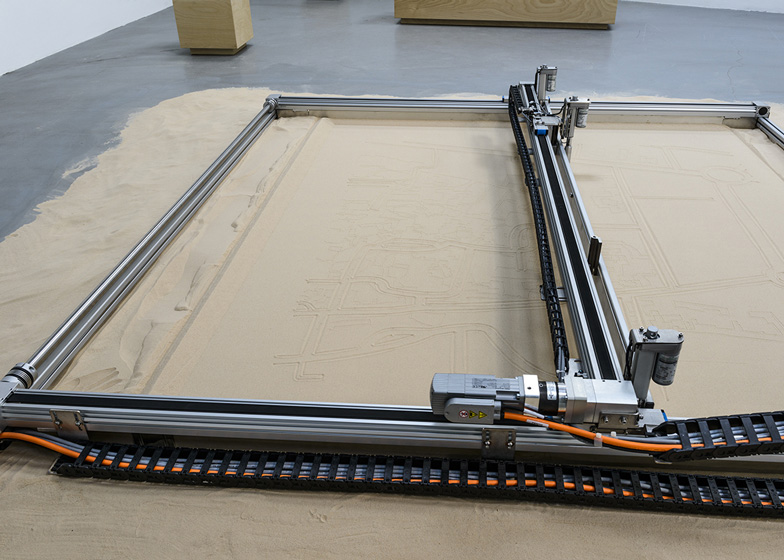Venice Architecture Biennale 2014: four machines trace patterns in piles of sand to reveal plans of buildings, neighbourhoods and cities in this installation at the Israeli Pavilion (+ slideshow).
Curated by architect Ori Scialom, lecturer Roy Brand, artist Keren Yeala-Golan and designer Edith Kofsky, the exhibition is entitled The Urburb and addresses the sprawl of housing developments across Israel in the last century.
Four large devices, described by the team as "sand printers", are positioned on the floors of the pavilion's three levels. Each one is dedicated to a different scale of development and has been programmed to trace a series of plans, one after another.
The first shows four masterplans for Israel, showing the locations of settlements from 1949 up to the present day. After each has been drawn, the machine erases the drawing and moves on to the next.
Four city plans are shown by the second machine, revealing different strategies for Jerusalem, Holon, Hadera and Yahud.
The third machine is dedicated to neighbourhood layouts, while the fourth demonstrates how residential building plans have evolved across the decades.
"The main perception of planning in Israel is top-down masterplanning, which is why we chose to show only plans and 2D drawings to tell the story of the evolution of the planning idea," Scialom told Dezeen.
According to Scialom, the exhibition was intended as an abstraction of reality. It is accompanied by a book that shows the physical reality of these fragmented communities, from early twentieth-century garden cities to mid-century social housing.
"Until now Israeli architects didn't want to look at these places controlled by engineers and large corporations," explained Scialom. "But we should look at it, and we should start to understand how we can change it because soon we'll not have cities anymore, we'll only have this urban mesh."
"Even the city centres are being replaced by these areas," she continued. "So by showing these areas very simply and nicely in 2D, we hope people will relate it to them and start to rethink."
The Urburb is on show at the Israeli Pavilion, in the Giardini of the Venice Architecture Biennale 2014 until 23 November. Other exhibitions include a reconstruction of the Chancellor's Bungalow at the German pavilion and
Here's a project description from the exhibition organisers:
The Urburb: Patterns of Contemporary Living
The Urburb presents a reflection upon 100 years of modernist development in Israel. The Urburb is a neologism which refers to the contemporary mesh of urban and suburban sprawl – a fragmented mosaic composed of the early twentieth century garden-city, agrarian settlements, mid-century social housing, and the generic residential typologies of the past two decades. This hybrid manifests the conflicting demands of the modernist machine functioning in the old-new land: to create small egalitarian communities while accommodating a large and diverse population; to spread throughout the country while converging and closing-in, and to reconnect to the land yet to do so via a top-down planning system that treats the surface as a clean slate.
In order to explore these dynamics, curators Ori Scialom, Dr. Roy Brand, Keren Yeala-Golan and Associate Curator Edith Kofsky transform the Israeli pavilion into a modernist construction site, filled with four large sand-printers, which automatically sketch the story of one hundred years of modernist planning in Israel, shifting in scale from national plans to those of single buildings. The printers are accompanied by a large-scale video and sound piece by Daniel Kiczales that plays the Urburb patterns as a music box.
The printers present a multiplicity of scenarios dealing with themes like over-planning, pattern language, and the dynamics of printing and erasing. In the endlessly expanding Urburb environment, new residential communities continue to pop up, separated by large expanses of open land-locked in, dislocated and separated from the urban grid. The complete sequence takes days to repeat. Regardless, no matter when you enter, the impression left is remarkably consistent; it conveys the experience of living within a modernist machine, under the signs of automation and the promise of utopian redemption. As quickly as the various schemes are etched into the sand, so are they wiped away, emphasising how these generic pattern-oriented plans are "printed" from above according to changing ideologies and evolving masterplans.
In keeping with the curator's experiential approach, the theoretical research is not presented on the walls of the space, but rather through a multi-disciplinary book titled The Urburb, published by Sternthal Books. The book exists as both a printed edition and a digital E-Book, and presents visual and theoretical research alongside philosophical and cultural texts by many of Israel’s most prolific writers, including Amos Oz, Julia Fermentto, Eyal Sagui Bizawe, Zvi Efrat, Tamar Berger, Eshkol Nevo, and Shimon Adaf. The edition also details the evolution of the various building typologies that make up the Israeli built environment, exposing the sociological implications of these transformations.
The Urburb is more than an architectural phenomenon, it is a state of mind and a form of life. Today, in the wake of one hundred years of modernism, it is time to explore its dynamics and understand the life it has fostered. Swinging between two parallel vectors—repetitive actions and fixed notions—the Urburb is the result of a particular modernist trajectory leading from an early emphasis on simplicity, compactness and equality to the inflated and homogenous neo-liberal formations of today.











